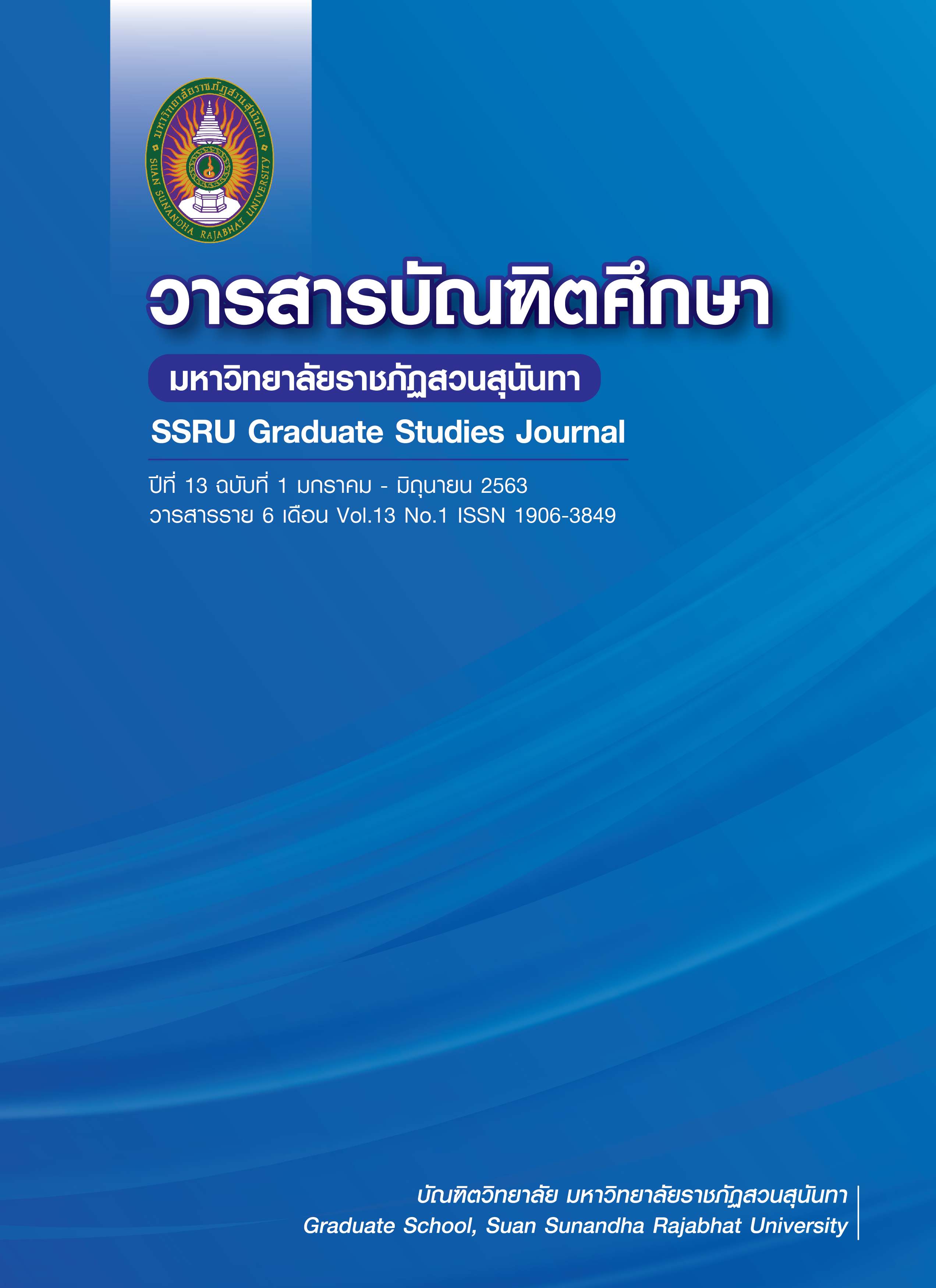Management of Community-Based Tourism: A Case of Baan Chak Ngaeo Chinese Market, Bang Lamung District, Chonburi Province
Main Article Content
Abstract
The objectives of this research were to: 1) study the potentials of tourism management in an old Chinese community in Bang Lamung District, Chonburi Province called Chak Ngaeo; and 2) develop a way to promote community-based tourism in this community. This research employed a qualitative methodology. Data were collected via in-depth interviews with 10 key informants consisting of five government officials, 10 shop owners, and 5 committees in the community. Data were organized, summarized and analyzed based on main points found from interviews transcripts. Triangulation was used to cross-check the data.
The research findings reveal that the tourism in Chak Ngaeo community can satisfy tourists’ requirements. Most of tourists visit the village for recreation. The local market in the community opens only one day a week on Saturdays. The market is outstanding in terms of decoration, dressing style of locals, food and beverage on sales, wooden houses and other local culture. Apart from the local market, there is the ‘Chao Mae Thapthim Shrine’ which is a sacred place where many tourists come to pay respect and ask for blessing. There was an annual festival called the Moon Festival which has been celebrated since the ancient time. The community has allowed tourists to visit and experience local ways of life. Tourists are impressed by local uniqueness of the community. The community needs to preserve and maintain such uniqueness. In addition, it was found that tourism also plays a role in the development of quality of life and economic of people in the community as it has generated revenues for local people from selling products including souvenirs and foods and drinks. The local people participate in the management of the areas such as determining specific areas for tourism activities such as shops, resting points for tourists, parking space, toilets and information centers. They also provide safety measures and other tourism facilities for tourists. These things attract more tourists to visit the community and make the local market stay with the community forever.
Article Details
References
มหาวิทยาลัยกรุงเทพ.
กรมท่องเที่ยว. (2559). สรุปรายได้และค่าใช้จ่ายการท่องเที่ยวจากนักท่องเที่ยวชาวต่างชาติที่เดินทางเข้าประเทศไทยปี 2558, สืบค้นเมื่อ 24 ตุลาคม 2561,เข้าถึงได้จาก
www.tourism.go.th
กระทรวงการท่องเที่ยวและกีฬา. (2557). นโยบายด้านการท่องเที่ยว.สืบค้นเมื่อ 20 ตุลาคม 2562. เข้าถึงได้จาก www.mots.go.th.
ชายชาญ ปฐมกาญจนา และนรินทร์ สังข์รักษา. (2558). แนวทางการส่งเสริมการท่องเที่ยวเชิงวัฒนธรรมแบบมีส่วนร่วมของชุมชนตลาดบางหลวง อำเภอบางเลน จังหวัด
นครปฐม. หลักสูตรปริญญาศึกษาศาสตร์มหาบัญัณฑิต. สาสขาบริหารการศึกษา คณะศึกษาศาสตร์มหาวิทลัยศิลปากร.
ชาย โพธิ์สิตา .(2554). ศาสตร์และศิลป์แห่งการวิจัยเชิงคุณภาพ (พิมพ์ครั้งที่ 5). กรุงเทพฯ: อมรินทร์.
ดรรชนี เอมพันธุ์. (2550). การพัฒนาการท่องเที่ยวโดยชุมชนและการจัดกิจกรรมโฮมสเตย์. กรุงเทพฯ: สานักพิมพ์มหาวิทยาลัยเกษตรศาสตร์.
วีระพล ทองมา. (2559). การท่องเที่ยวโดยชุมชน (Community Based Tourism: CBT) สำหรับการพัฒนาคุณภาพชีวิตของชุมชนในเขตที่ดินป่าไม้. สืบค้นเมื่อ 24
สิงหาคม 2559, เข้าถึงได้จาก www.dnp.go.th
รุ้งนภา ด้วงทอง. (2554). ศักยภาพการท่องเที่ยวเชิงวัฒนธรรมของตลาดเก่า 119 ปี เจ็ดเสมียน ตำบลเจ็ด
เสมียน อำเภอโพธาราม จังหวัดราชบุรี. หลักสูตรปริญญาศิลปศาสตร์มหาบัณฑิต.สาขาวิชาการจัดการภาครัฐและเอกชน. บัณฑิตวิทยาลัย มหาวิทยาลัยศิลปากร.
รัฐนันท์ พงศ์วิริทธิ์ธร และภาคภูมิ ภัควิภาส. (2556). แนวทางการพัฒนาการท่องเที่ยวเชิงวัฒนธรรมชนเผ่าเพื่อความยั่งยืน. คณะบริหารธุรกิจและศิลปศาสตร์ มหาวิทยาลัย
เทคโนโลยีราชมงคลพายัพ เชียงใหม่.
เทิดชาย ช่วยบำรุง. (2552). บทบาทขององค์กรปกครองส่วนท้องถิ่นกับการพัฒนาการท่องเที่ยวอย่างยั่งยืนบนฐานแนวคิดเศรษฐกิจพอเพียง. กรุงเทพฯ: สานักพิมพ์คณะ
รัฐมนตรีและราชกิจจานุเบกษา.
แผนพัฒนาการท่องเที่ยวแห่งชาติ ฉบับที่ 2 พ.ศ. (2560-2564). วิสัยทัศน์การท่องเที่ยวไทย พ.ศ.2579. (วิสัยทัศน์ 20 ปี). คณะกรรมการนโยบายการท่องเที่ยวแห่งชาติ
สืบค้นเมื่อ 1 พฤศจิกายน 2562 เข้าถึงได้จาก https://www.thai-garman-cooperation.info.
สำนักงานปลัดกระทรวงการท่องเที่ยวและกีฬา. (2560) แผนพัฒนาการท่องเที่ยว ฉบับที่ 2 ปีพ.ศ. 2560-2564
สำนักงานกิจการโรงพิมพ์องค์การสงเคราะห์ทหารผ่านศึก สืบค้นเมื่อ 18 พฤศจิกายน 2562 เข้าถึงได้จาก https://www.dot.go.th
สุภางค์ จันทวานิช. (2554). การวิเคราะห์ข้อมูลในการวิจัยเชิงคุณภาพ. กรุงเทพฯ: พิมพ์ครั้งที่ 10. สำนักพิมพ์แห่งจุฬาลงกรณ์มหาวิทยาลัย.
สถาบันการท่องเที่ยวโดยชุมชน. (2560). ประโยชน์ที่ชุมชนได้รับ. สืบค้นเมื่อ 15 ตุลาคม 2562. เข้าถึงได้จาก www.cbt-i.or.th
Dickman, S. (1996). Tourism: An Introductory Text. (2nd ed). Sydney: Hodder Education.
Kotler, P. (2000). Marketing Management: Analysis, Planning, Implementation, And Control (10th ed.). New Jersey: Prentice Hall.


